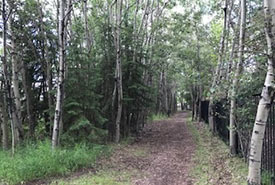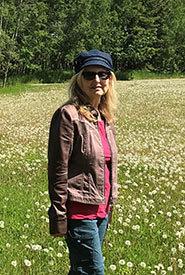How spending time in nature benefits your baby’s gut health

Sleeping infant (Photo by Daisy Laparra from Pexels)
Being close to nature has motivated my life choices — where I live and how I spend my free time. In these times of COVID-19, where I work is now where I live, and I am lucky to live on a ravine in one of Edmonton’s natural areas, as mapped out in the urban Primary Land and Vegetation Inventory (uPLVI).

Edmonton ravine (Photo by Anita Kozyrskyj)
Through my windows, I have witnessed nature at its best: a porcupine scaling a bird feeder, mama moose sauntering with twins in tow, an owl having rabbit for dinner and a squirrel chasing a weasel. These days, I am seeing a greater number of humans in the ravine.
Recently, I had a wonderful opportunity to demonstrate the health benefits of nature in my own microbiome research in the Department of Pediatrics at the University of Alberta, using Edmonton’s uPLVI map of natural green spaces. My study examined gut bacteria in poop from 355 four-month-old babies in the CHILD Cohort Study. This national study is following Canadian children from before birth, with the goal of discovering the root causes of chronic disease. Babies’ postal codes were cross-referenced with the Edmonton’s uPLVI map to determine lived distance from a natural space. Published in the journal Environment International, this is the first study to show that living close to natural green space can mitigate some of the changes in infant gut bacteria associated with formula feeding.
Mother’s milk is optimal; it reduces the chances of a baby developing respiratory infections or becoming overweight. But not every baby can be breastfed. In my study, babies who lived within 500 metres of a natural environment had lesser diversity of their gut bacteria. This result seems counterintuitive, but not when you learn that a breastfed baby has lower gut bacterial diversity than a formula-fed baby. This is because the sugars in formula promote the growth of different gut bacteria than those found with breastfeeding.

Baby and dog (Photo by Ricardo Esquivel from Pexels)
Gut bacteria in babies is vital to their normal development. The greatest benefit to gut bacteria in my study was shown for formula-fed babies living in a home with a pet. Though the exact mechanism is not known, babies can pick up healthy bacteria from nature brought into the home by their parents after dog walking, or by the pets themselves. I often receive emails from new mothers who are unable to breastfeed and are concerned about their baby’s health. Based on the results of my study, I can now advise them to bring their babies along for a walk in natural areas and consider getting a dog to make this a routine.
It took an interdisciplinary team — a geographer, a city planner, pediatricians and international environmental and microbiome scientists — to make this project happen. The project was a unique use of the already novel and award-winning uPLVI map, created by the City of Edmonton to better understand how urban natural assets support plant and animal biodiversity, ecological connectivity and improve air quality.
Forest bathing has been gaining popularity worldwide as a remedy for many ailments. During the pandemic, our Canadian forests and other natural spaces have been places of refuge and recreation. Should this love affair with nature endure, it will have extended health benefits for the next generation. In the words of American architect, writer and educator Frank Lloyd Wright, “Study nature, love nature, stay close to nature. It will never fail you.”


